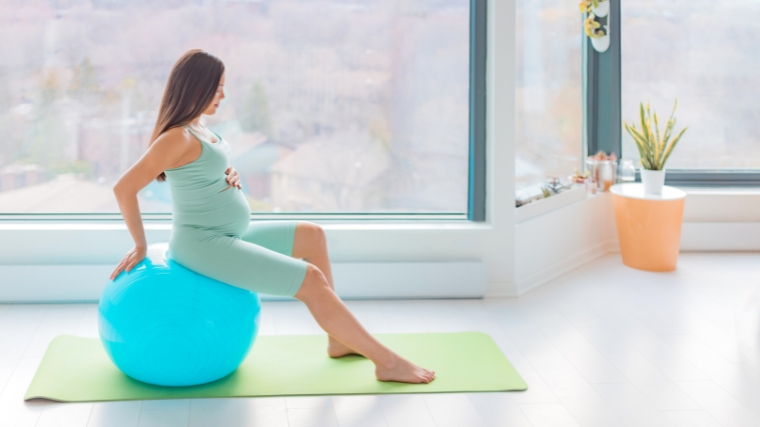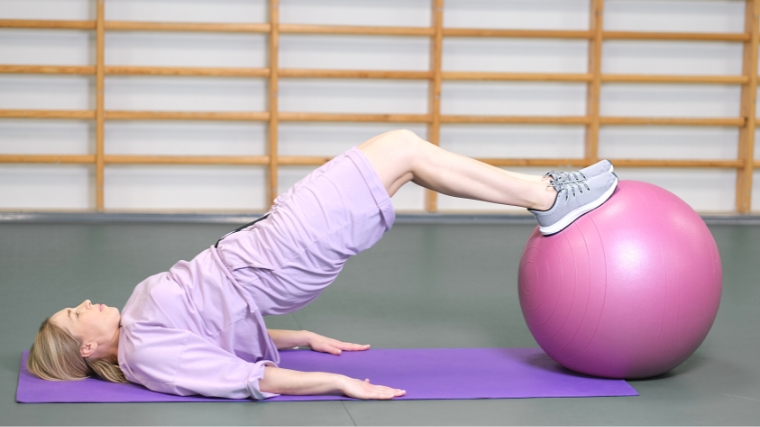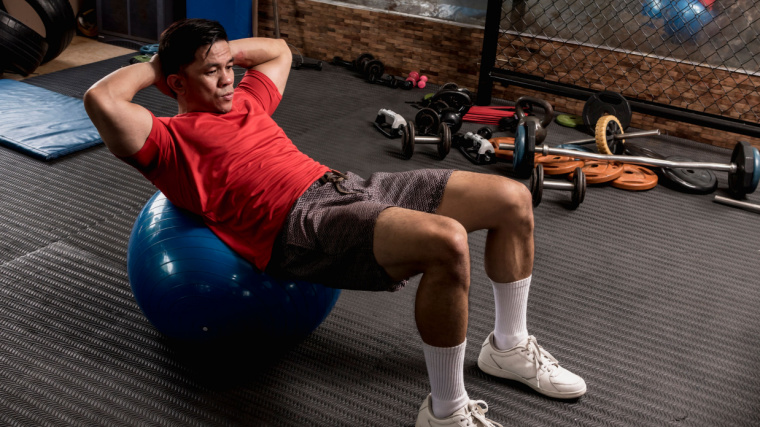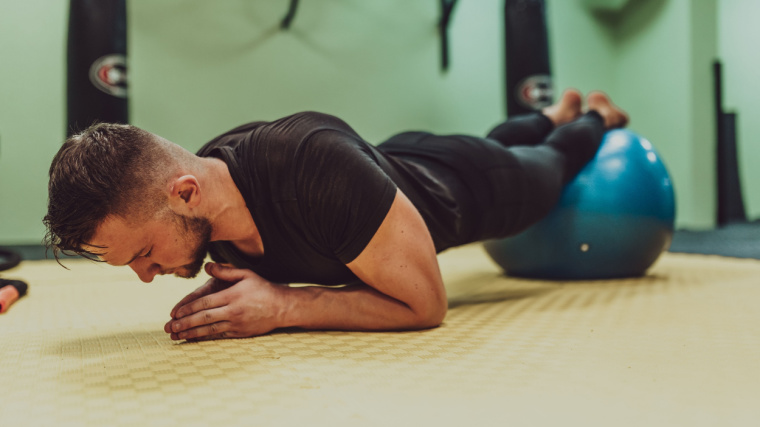Stationed amidst dense steel barbells, cable machines, and kettlebells, inflated plastic spheres are rolling around commercial gyms. If there isn’t a knee-high ball in your fitness center, you may want to consider tossing one of the big orbs into your workout routine at home. The stability ball is the edgeless equipment that can give your training program an edge.
You may recognize the round accessory as a makeshift office chair, but it’s so much more than that. Its name alone signifies the benefits of the stability ball — because it’s so unstable and wobbly, it will make your body more stable and steady.

The stability ball can aid in powering precise pushes and pulls on the platform and expand your range of motion for flawless form on the field. Slide a stability ball into your strength routine to synchronize your mind-muscle connection and build tremendous core strength. Here’s how — and why — you should.
Editor’s Note: The content on BarBend is meant to be informative in nature, but it should not be taken as medical advice. When starting a new training regimen and/or diet, it is always a good idea to consult with a trusted medical professional. We are not a medical resource. The opinions and articles on this site are not intended for use as diagnosis, prevention, and/or treatment of health problems. They are not substitutes for consulting a qualified medical professional.
Benefits of the Stability Ball
- Back Pain Prevention and Rehab
- Improved Posture
- More Core Strength
- Enhanced Body Awareness and Coordination
- Increased Balance
- Expanded Range of Motion and Mobility
Back Pain Prevention and Rehab
The stability ball is a staple in many spaces, from commercial gyms and pilates studios to garage and home gyms. It is also tremendously popular in the world of physical rehabilitation. And with good reason.
If you spend a lot of time sitting each day, stability ball exercises can help improve your postural stability and reduce the risk of low back pain. (1) Research has shown that people who experience chronic low back pain can alleviate their symptoms with lumbar stabilizing exercises on the stability ball. (2)
For people who are pregnant, exercising on a stability ball can help minimize low back pain and increase day-to-day functionality. (3)

One potential way that stability balls can help here is by actually strengthening your lower back in a low-impact, non weight-bearing environment. (4) By helping make your lower back stronger without adding compressing your spine under load, you’re setting yourself up for success when you do get back under a barbell.
Improved Posture
Sitting for hours at a time while looking at a computer or phone can cause havoc for someone’s posture. As your back and neck hunch forward, it’s very easy for your muscles to cramp up and for your joints to become painful.
Low postural awareness can have severe consequences, as it strains your lower back and hip flexors. These consequences show up in the gym too, impacting exercises as broad-ranging as deep squats and walking lunges to overhead presses and even jogging.

Doing exercises on a stability ball’s unstable surface has been shown to increase people’s postural stability, which can lead to reduced back pain and greater back strength. (1)(4) This can pay big dividends in the weight room.
The more upright your posture, the more likely you may be to maintain a neutral spine under load. For example, during a heavy deadlift or squat, you need to be able to keep your back from losing postural integrity. The more postural control you can reap from exercises like those on a stability ball, the better off you’ll be.
More Core Strength
The core is the powerhouse for strength athletes. It is the center for coordination, stability, and control. An athlete’s performance is ultimately both linked to and limited by their core’s ability to effectively transmit force.
Moves as wide-ranging and important as thrusters, squats, and kettlebell swings all engage the core, which is made up of muscles surrounding your trunk: abdominals, obliques, diaphragm, pelvic floor, trunk extensors, and hip flexors. You need solid core strength to handle the weight of a loaded barbell.

So, how do you strengthen your core? You have to exercise it more. However, this may mean doing more than the exercises in your existing program. Many programs are focused on building muscle through resistance training — and rightly so. But squats and deadlifts just aren’t enough to build the kind of strong, stable core you need.
It is crucial to make your accessory exercises match your performance goals. Adding stability ball exercises to a program helps give you the baseline of core strength you need to transmit force more effectively through your core.
Enhanced Body Awareness and Coordination
The stability ball’s name is a bit of a misnomer — it’s actually very unstable. That’s exactly what makes it a great tool for athletes. By using it as an exercise surface, your entire body will have to coordinate to keep yourself balanced.
Remaining stable on the ball creates body consciousness. You’ll become very aware of just how much your body relies on your torso to stay steady. Working on the stability ball also highlights just how necessary it is to mentally locate smaller muscles and contract them.

Improved coordination from stability ball exercises will help you target specific muscles. This will engage your central nervous system to activate specific muscles, such as those in the calf, to stabilize your deadlift pull. It can also benefit your poses on stage as your mind is trained to flex isolated parts of your body.
Variations of any number of stability ball exercises all require keen attention to the muscles across your whole body. This heightened awareness of your muscles will help you shift the ball in controlled directions or keep it in place.
Increased Balance
Many people do not recognize the need for balance until their lift is “off.” Once you’ve hit a plateau, the need for balance may become much more apparent. If you have muscle imbalances across your body, these can prevent your strength from growing with a domino effect that can collapse your form and technique.
To do a bilateral exercise — like benching — both sides of the body have to be in unison. If you dip to one side repeatedly, the imbalance of pressure and angle can cause tension or even injury. In the best-case scenario, side dominance just make your muscles look asymmetrical, with one side dominating the other.

[Read More: The Best Bodyweight Exercises, + Workouts and Tips From a CPT]
But you don’t just have to be balanced side-to-side. You also want a front-to-back balance. While benching builds your chest and arm muscles, back muscles get put on the back burner in this exercise (even though your lats play a big supporting role). Strong front muscles that are growing combined with a weak back can make lifting heavier loads challenging.
On a stability ball, all sides of your body need to work together to maintain balance. If one side or area is dominating another, you’ll tip over. Because of this, the stability ball is an excellent way to call attention to areas where you might need more unilateral training. Exercising on the ball will teach you to pay heed to those differences and start to correct them.
Expanded Range of Motion and Mobility
Having the muscle capacity to lift is one part of being a good strength athlete — but having the mobility to perform as an athlete is another necessity. You will not squat to the grass if your body’s range of motion and mobility limits you from bending below your knees.
The stability ball offers a wide variety of exercises that can help you extend your range of motion to ultimately boost your mobility. For example, the stability ball shoulder ROM is directly targeted toward improving your overhead mobility.

But even moves like the superman to batman and stability ball push-ups will require you to reach into a range of motion that you just won’t access when you’re working on the floor or on a weight bench.
What’s more, stability ball exercises are not limited to the ground. Prop one on a wall to work on upper body movements with your arms. By giving yourself some distance from a wall, you’ll be able to reach much farther overhead and behind you without hyperextending your back.
[RELATED: The Best Mobility Exercises]
Stability Ball Exercises
Exercising on a stability ball is a great way to maintain your workout momentum even when your muscles are too tired to pull another high-intensity clean & jerk. It can add creative variety with less intensity while still developing your abilities as an athlete.
Here, you’ll find some stability ball exercises you can add to your routine for big gains without high impact on your joints.
Superman to Batman
Power your arms forward like superman, then extend them to continue flying like — you guessed it — batman. This movement will work on your arms’ extension while bringing your core toward the strength of a superhero.
While you will not be able to fly from this exercise, the elevation of your trunk will go on to support a greater range of motion and strength in your overhead position, core, and upper back.
Stability Ball Row
Keep increasing your upper back strength with rows on a stability ball. The ball offers support, but it’s unstable in nature. So your core and even your legs will have to work overtime to keep your upper body stable enough to row.
You may only need light dumbbells here, as the true challenge will be maintaining balance. And because you’ll be focused so much on staying stable, you won’t be able to use momentum to hoist the dumbbell up. It’ll all be down to your back muscles, which is exactly what you want.
Stability Ball Push-Up
The stability ball will engage your core while practicing stability on a wobbly surface. The extra challenge from an uneven surface will be rewarded in spades for your chest, arms, and core. Even your glutes will be involved in maintaining balance and strength.
You can perform these push-ups at an incline with your hands balancing on the ball. Alternatively, you can do these with your feet balancing on the ball and your hands on the ground.
Stability Ball Shoulder ROM
This one is a real doozy for extending your shoulder’s ROM (range of motion). You’ll move in a slow, controlled manner to make sure you’re staying stable while also getting in the biggest stretch you can.
Work on your range of motion by controlling the ball on the ground. Move it as far away as possible in different directions with your palm. Extend the ball out, then bring it back toward your head. Repeat this motion as if you were trying to hit numbers on a clock.
Single-Leg Hip Thrust
This exercise is great for getting in some serious bodyweight glute work. Thrust each leg with a purpose while strengthening your leg muscles individually.
The single-leg hip thrust trains hip extension and is an optimal glute exercise. Your lower back will appreciate the break from the heavily-loaded glute movements that might otherwise populate your program.
[RELATED: Best Leg Exercises]
Stability Ball Pelvic Lift
Your lower back, lower abdominals, and glutes will get a big boost from the extensive attention here. The stability ball pelvic lift is great for balance, as your heels work to keep your body stable on the ball.
You’ll also be challenging your flexibility as you squeeze your glutes and lift your hips as high as possible. The motion has great carryover potential to locking out a deadlift.
Stabilize Your Lifts
The stability ball might not be the sexiest piece of fitness equipment out there. It doesn’t have the allure of the pull-up bar or the bragging rights of a loaded barbell. But if you use them right, you can use stability balls to develop the baseline of strength you need on the platform.
By strengthening your core and improving coordination across your entire body, the stability ball can work wonders for your performance in and out of the gym. The rubber equipment may not inflate your muscles, but it will help you roll toward your goals so you can lift heavier and faster.
References
- Carter JM, Beam WC, McMahan SG, Barr ML, Brown LE. The effects of stability ball training on spinal stability in sedentary individuals. J Strength Cond Res. 2006 May;20(2):429-35.
- Yoon JS, Lee JH, Kim JS. The effect of swiss ball stabilization exercise on pain and bone mineral density of patients with chronic low back pain. J Phys Ther Sci. 2013 Aug;25(8):953-6.
- Yan CF, Hung YC, Gau ML, Lin KC. Effects of a stability ball exercise programme on low back pain and daily life interference during pregnancy. Midwifery. 2014 Apr;30(4):412-9.
- Sukalinggam CL, Sukalinggam GL, Kasim F, Yusof A. Stability Ball Training on Lower Back Strength has Greater Effect in Untrained Female Compared to Male. J Hum Kinet. 2012 Jun;33:133-41.
Featured Image: Rawpixel.com / Shutterstock.com